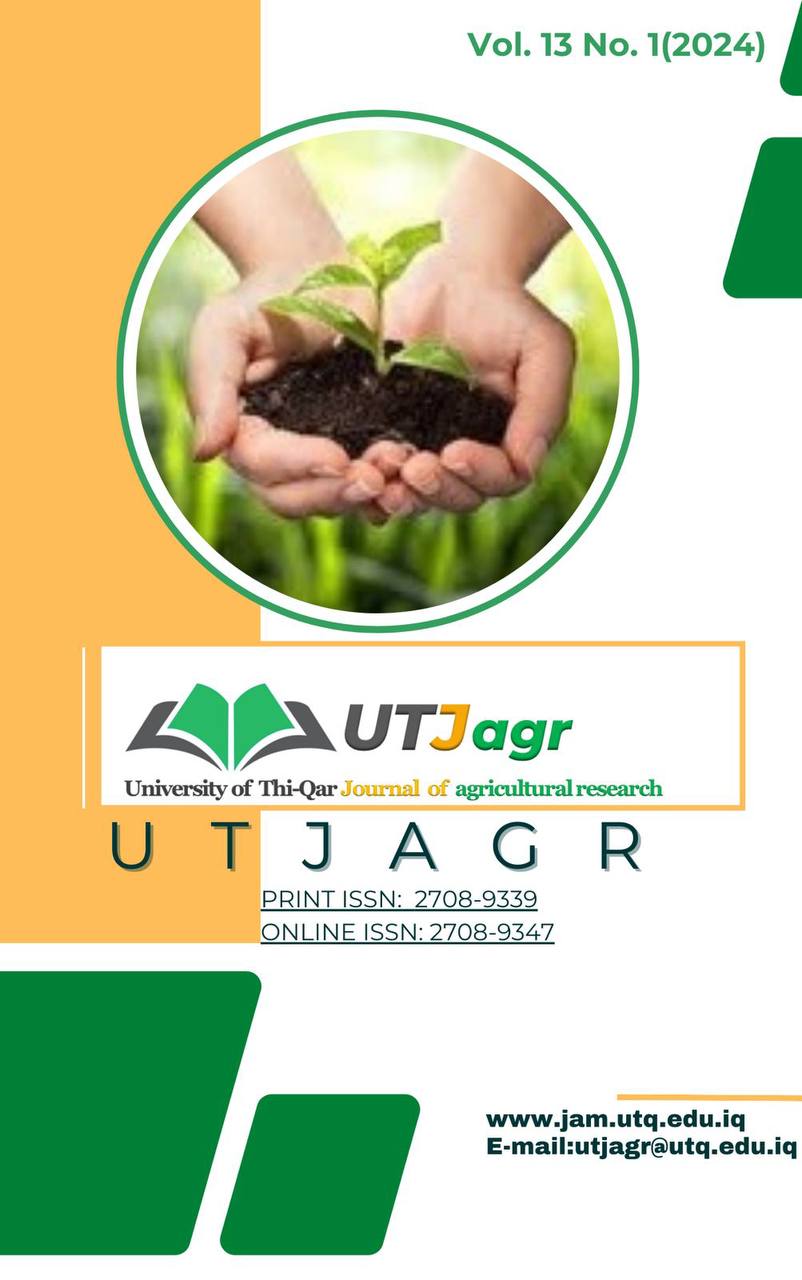Impact of Humic Substances on Alleviation of Soil Salinity and the Enhancement of Plant Productivity: a review
DOI:
https://doi.org/10.54174/szm42027Keywords:
Humic, germination, salinity, plant growthAbstract
-
Humic substances (HS) are a major component of organic matter in soil, and they have long been recognized for their ability to promote plant growth in a sustainable manner. Recently, there has been a lot of effort put into using multiple approaches to study the connection between the chemical structure of HS compounds and their effect on plant biological processes. Positive physiological responses at the local and systemic levels have been linked to the presence of specific functional groups in HS. Hormone-like signaling pathways are responsible for eliciting these reactions. This review was written with one goal in mind: to help readers gain a firm grasp on the research surrounding the application of HSs. The spatial arrangement of hydrophilic and hydrophobic regions, as well as the dosage, source, molecular size, degree of hydrophobicity, and aromaticity, all contribute significantly to HS's biological efficacy. Therefore, our hypothesis explains the beneficial effect of HS in salt-affected rhizospheres, likely attributed to both direct and indirect influences on plant metabolism, soil microorganism metabolism, soil nutrient uptake dynamics, and soil physical conditions. Keywords: Humic substance, germination, salinity, plant growth
Downloads
References
Al-Barakat, H. N. K., ghazi Neghamish, R. & Al-Shujairy, Q. A. The Effect of Some Chemical Compounds and Plants Water Extracts on Inhibiting The Nitrification in The Soil and Wheat (Triticum Aestivuim L.) Growth and Yield. IOP Conference Series: Earth and Environmental Science, 2021. IOP Publishing, 012077.
Al-Bayati, H. J. & Ali, K. R. 2019. Effect of planting depth and zinc sulphate spraying on growth and yield of potato (Solanum tuberosum L.). Basrah Journal of Agricultural Sciences, 32, 90-97.
Aresta, M., Dibenedetto, A. & Angelini, A. 2013. The use of solar energy can enhance the conversion of carbon dioxide into energy-rich products: stepping towards artificial photosynthesis. Philosophical Transactions of the Royal Society A: Mathematical, Physical and Engineering Sciences, 371, 20120111.
Avramenko, V., Bratskaya, S. Y., Yakushevich, A., Voit, A., Ivanov, V. & Ivannikov, S. 2012. Humic acids in brown coals from the southern Russian Far East: general characteristics and interactions with precious metals. Geochemistry International, 50, 437-446.
Baligar, V. & Fageria, N. 2007. Agronomy and physiology of tropical cover crops. Journal of Plant Nutrition, 30, 1287-1339.
Boumya, W., Khnifira, M., Machrouhi, A., Abdennouri, M., Sadiq, M., Achak, M., Serdaroğlu, G., Kaya, S., Şimşek, S. & Barka, N. 2021. Adsorption of Eriochrome Black T on the chitin surface: Experimental study, DFT calculations and molecular dynamics simulation. Journal of Molecular Liquids, 331, 115706.
Corwin, D. L. 2021. Climate change impacts on soil salinity in agricultural areas. European Journal of Soil Science, 72, 842-862.
Darusman, D., Devianti, D. & Husen, E. 2018. Improvement of soil physical properties of cambisol using soil amendment. Aceh International Journal of Science and Technology, 7, 93-102.
Detmann, K. C., Araújo, W. L., Martins, S. C., Sanglard, L. M., Reis, J. V., Detmann, E., Rodrigues, F. Á., Nunes‐Nesi, A., Fernie, A. R. & DaMatta, F. M. 2012. Silicon nutrition increases grain yield, which, in turn, exerts a feed‐forward stimulation of photosynthetic rates via enhanced mesophyll conductance and alters primary metabolism in rice. New Phytologist, 196, 752-762.
Doornbusch, G., Tedesco, M., Post, J., Borneman, Z. & Nijmeijer, K. 2019. Experimental investigation of multistage electrodialysis for seawater desalination. Desalination, 464, 105-114.
El-Hendawy, S. E., Hassan, W. M., Al-Suhaibani, N. A., Refay, Y. & Abdella, K. A. 2017. Comparative performance of multivariable agro-physiological parameters for detecting salt tolerance of wheat cultivars under simulated saline field growing conditions. Frontiers in plant science, 8, 435.
El-Katony, T. M., Deyab, M. A., El-Adl, M. F. & Ward, F. M. E.-N. 2021. Extracts of the brown alga Dictyota dichotoma (Hudson) JV Lamouroux alleviate salt stress in rice (Oryza sativa L.) during germination. Journal of Plant Growth Regulation, 40, 986-999.
El Hasini, S., De Nobili, M., El Azzouzi, M., Azim, K., Douaik, A., Laghrour, M., El Idrissi, Y., El Alaoui El Belghiti, M. & Zouahri, A. 2020. The influence of compost humic acid quality and its ability to alleviate soil salinity stress. International journal of recycling organic waste in agriculture, 9, 21-31.
EL Sabagh, A., Islam, M. S., Skalicky, M., Ali Raza, M., Singh, K., Anwar Hossain, M., Hossain, A., Mahboob, W., Iqbal, M. A. & Ratnasekera, D. 2021. Salinity stress in wheat (Triticum aestivum L.) in the changing climate: Adaptation and management strategies. Frontiers in Agronomy, 3, 661932.
Etesami, H. & Maheshwari, D. K. 2018. Use of plant growth promoting rhizobacteria (PGPRs) with multiple plant growth promoting traits in stress agriculture: Action mechanisms and future prospects. Ecotoxicology and environmental safety, 156, 225-246.
Fageria, N. K., Stone, L. F. & Santos, A. B. d. 2012. Breeding for salinity tolerance. Plant breeding for abiotic stress tolerance, 103-122.
Fang, S., Hou, X. & Liang, X. 2021. Response mechanisms of plants under saline-alkali stress. Frontiers in Plant Science, 12, 667458.
FitzGerald, K., Nairn, J., Skennerton, G. & Atrens, A. 2006. Atmospheric corrosion of copper and the colour, structure and composition of natural patinas on copper. Corrosion Science, 48, 2480-2509.
Francois, L., Donovan, T. & Maas, E. 1984. Salinity Effects on Seed Yield, Growth, and Germination of Grain Sorghum 1. Agronomy Journal, 76, 741-744.
Gkiougkis, I., Kallioras, A., Pliakas, F., Pechtelidis, A., Diamantis, V., Diamantis, I., Ziogas, A. & Dafnis, I. 2015. Assessment of soil salinization at the eastern Nestos River Delta, NE Greece. Catena, 128, 238-251.
Gouda, S., Kerry, R. G., Das, G., Paramithiotis, S., Shin, H.-S. & Patra, J. K. 2018. Revitalization of plant growth promoting rhizobacteria for sustainable development in agriculture. Microbiological research, 206, 131-140.
Gregorio, G., Islam, M., Vergara, G. & Thirumeni, S. 2013. Recent advances in rice science to design salinity and other abiotic stress tolerant rice varieties. Sabrao J Breed Genet, 45, 31-41.
Hameed, A., Ahmed, M. Z., Hussain, T., Aziz, I., Ahmad, N., Gul, B. & Nielsen, B. L. 2021. Effects of salinity stress on chloroplast structure and function. Cells, 10, 2023.
Hameed, A., Fatma, S., Wattoo, J. I., Yaseen, M. & Ahmad, S. 2018. Accumulative effects of humic acid and multinutrient foliar fertilizers on the vegetative and reproductive attributes of citrus (Citrus reticulata cv. kinnow mandarin). Journal of Plant Nutrition, 41, 2495-2506.
Heidari, M. & Jamshid, P. 2010. Interaction between salinity and potassium on grain yield, carbohydrate content and nutrient uptake in pearl millet. ARPN Journal of Agricultural and Biological Science, 5, 39-46.
Helmey, R. 2021. Using Sugarcane Waste to Reduce Cytogenetic Impairment in Vicia faba Exposed to Saltiness Stress. Egyptian Journal of Botany, 61, 41-51.
Heuer, B. 2010. Role of proline in plant response to drought and salinity. Handbook of plant and crop stress, 3, 213-238.
Hossain, A., Krupnik, T. J., Timsina, J., Mahboob, M. G., Chaki, A. K., Farooq, M., Bhatt, R., Fahad, S. & Hasanuzzaman, M. 2020. Agricultural land degradation: processes and problems undermining future food security. Environment, climate, plant and vegetation growth. Springer.
Hussain, M. I., Farooq, M., Muscolo, A. & Rehman, A. 2020. Crop diversification and saline water irrigation as potential strategies to save freshwater resources and reclamation of marginal soils—A review. Environmental Science and Pollution Research, 27, 28695-28729.
Jimtaisong, A. & Saewan, N. 2014. Utilization of carboxymethyl chitosan in cosmetics. International journal of cosmetic science, 36, 12-21.
Kumar, A., Bhattacharya, T., Mukherjee, S. & Sarkar, B. 2022. A perspective on biochar for repairing damages in the soil–plant system caused by climate change-driven extreme weather events. Biochar, 4, 22.
Leogrande, R. & Vitti, C. 2019. Use of organic amendments to reclaim saline and sodic soils: a review. Arid Land Research and Management, 33, 1-21.
Liu, M., Wang, C., Wang, F. & Xie, Y. 2019. Maize (Zea mays) growth and nutrient uptake following integrated improvement of vermicompost and humic acid fertilizer on coastal saline soil. Applied soil ecology, 142, 147-154.
Ma, Y., Dias, M. C. & Freitas, H. 2020. Drought and salinity stress responses and microbe-induced tolerance in plants. Frontiers in Plant Science, 11, 591911.
Nardi, S., Schiavon, M. & Francioso, O. 2021. Chemical structure and biological activity of humic substances define their role as plant growth promoters. Molecules, 26, 2256.
Nasri, N., Saïdi, I., Kaddour, R. & Lachaâl, M. 2015. Effect of salinity on germination, seedling growth and acid phosphatase activity in lettuce. American Journal of Plant Sciences, 6, 57.
Numan, M., Bashir, S., Khan, Y., Mumtaz, R., Shinwari, Z. K., Khan, A. L., Khan, A. & Ahmed, A.-H. 2018. Plant growth promoting bacteria as an alternative strategy for salt tolerance in plants: a review. Microbiological research, 209, 21-32.
Ohno, T., Hess, N. J. & Qafoku, N. P. 2019. Current understanding of the use of alkaline extractions of soils to investigate soil organic matter and environmental processes. Journal of Environmental Quality, 48, 1561-1564.
Raza, A., Tabassum, J., Fakhar, A. Z., Sharif, R., Chen, H., Zhang, C., Ju, L., Fotopoulos, V., Siddique, K. H. & Singh, R. K. 2022. Smart reprograming of plants against salinity stress using modern biotechnological tools. Critical reviews in biotechnology, 1-28.
Rose, M. T., Patti, A. F., Little, K. R., Brown, A. L., Jackson, W. R. & Cavagnaro, T. R. 2014. A meta-analysis and review of plant-growth response to humic substances: practical implications for agriculture. Advances in agronomy, 124, 37-89.
Sabah, M. A. G., Athfua, Q. J. & Eman, M. A. R. 2023. Effect of the hormone brosnolide and soil-enhancing polymer on the growth and yield of plants Okra (Abelmoschus esculentus L.) under two different irrigation periods. Texas Journal of Agriculture and Biological Sciences, 17, 78-88.
Sahle-Demessie, E., Hassan, A. A. & El Badawy, A. 2019. Bio-desalination of brackish and seawater using halophytic algae. Desalination, 465, 104-113.
Sarwar, N., Imran, M., Shaheen, M. R., Ishaque, W., Kamran, M. A., Matloob, A., Rehim, A. & Hussain, S. 2017. Phytoremediation strategies for soils contaminated with heavy metals: modifications and future perspectives. Chemosphere, 171, 710-721.
Shah, A. M., Khan, I. M., Shah, T. I., Bangroo, S. A., Kirmani, N. A., Nazir, S., Malik, A. R., Aezum, A. M., Mir, Y. H. & Hilal, A. 2022. Soil microbiome: a treasure trove for soil health sustainability under changing climate. Land, 11, 1887.
Sofy, M. R., Elhawat, N. & Alshaal, T. 2020. Glycine betaine counters salinity stress by maintaining high K+/Na+ ratio and antioxidant defense via limiting Na+ uptake in common bean (Phaseolus vulgaris L.). Ecotoxicology and Environmental Safety, 200, 110732.
VS, J. & Jacob, R. S. 2023. Management of Rain Water Structures. Traditional Rainwater Harvesting Structures. Springer.
Wasim, H. M., Sarwar, G., Tahir, M. A., Aftab, M., Manzoor, M. Z., Zafar, A., Shehzad, I., Riaz, A., Niaz, A. & Mufti, K. A. 2021. Deleterious Impact of Sodium Chloride (NaCl) Toxicity on Chemical Properties of Soil and Ionic Composition of Rice. Pakistan Journal of Agricultural Research, 34.
Wu, L., Guo, X. & Harivandi, A. 2001. Salt tolerance and salt accumulation of landscape plants irrigated by sprinkler and drip irrigation systems. Journal of Plant Nutrition, 24, 1473-1490.
Yang, F., Tang, C. & Antonietti, M. 2021. Natural and artificial humic substances to manage minerals, ions, water, and soil microorganisms. Chemical Society Reviews, 50, 6221-6239.
Zavarzina, A., Danchenko, N., Demin, V., Artemyeva, Z. & Kogut, B. 2021. Humic substances: hypotheses and reality (a review). Eurasian Soil Science, 54, 1826-1854.
Zhang, C., Li, X., Yan, H., Ullah, I., Zuo, Z., Li, L. & Yu, J. 2020. Effects of irrigation quantity and biochar on soil physical properties, growth characteristics, yield and quality of greenhouse tomato. Agricultural Water Management, 241, 106263.

Downloads
Published
Issue
Section
License
Copyright (c) 2023 Basim Abed, Elham Khalifa Mahmood, Abdullah M.S. Addaheri

This work is licensed under a Creative Commons Attribution-NonCommercial-ShareAlike 4.0 International License.







1.png)

